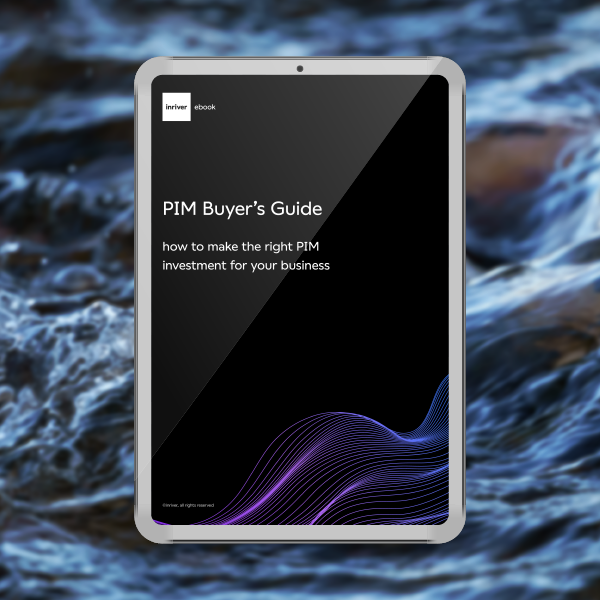PIM for catalog management
ensure your catalog is always up to date
Discover how you can streamline catalog management with a fully flexible PIM solution that will transform how you manage data.
As brands, manufacturers, and retailers grow, product catalog management becomes increasingly complex. But without the right systems in place, inconsistent data, outdated information, and lost details can easily creep in.
Is that simply the cost of managing a vast catalog? Or is there another, better way?
Product Information Management (PIM) software transforms product catalog management by providing a single source of truth for accurate product information. This ensures consistency, accuracy, and efficiency no matter your portfolio size or number of channels. Software-as-a-service (SaaS) PIM takes those benefits even further with improved scalability and lightning-fast deployment.
So is PIM catalog management the right solution for your business? Read on to find out.
What is a PIM system?
A PIM system is a centralized platform that manages all product-related data in one place. By implementing PIM best practices, businesses can ensure their systems operate at peak efficiency, maximizing the accuracy and usability of their product data. It serves as the single source of data truth for managing your production information, including:
- Product descriptions
- Media files
- SKUs
- Specifications and dimensions
- Pricing and discounts
Unlike traditional databases, PIM handles the complexities of catalog management. This includes data enrichment, syndication, and multichannel distribution.
“What is PIM?”
Hear inriver experts answer the all-important question.
Benefits of catalog management using PIM
The right PIM solution can transform product data into a powerful driver of growth, providing a range of competitive advantages for catalog management:
- Single source of truth: Apply updates or corrections to your catalog across all platforms with a single click, eliminating inconsistencies and saving you hours of manual work.
- Rich media integration: Craft engaging images, videos, and rich product descriptions to boost customer engagement and conversions.
- Consistency across channels: Keep your data in sync no matter where it’s at—from brick-and-mortar stores to e-commerce sites, marketplaces, and catalogs.
- Automated processes: Cut down on potential errors and time spent managing updates by automating key steps in the catalog creation process.
- Cross-functional collaboration: Streamline internal workflows with a unified platform where each team can contribute to and access updated product data.
- Market agility: Rapidly respond to market trends with accelerated new product launches, updates, and other changes, all managed from a single PIM catalog platform.
- Localization support: Easily translate and format product data to meet the needs of diverse markets, seamlessly scaling your catalog for global audiences.
Whether you’re aiming to leverage PIM for e-commerce, traditional retail, or B2B, advanced platforms offer an all-in-one solution to optimize every aspect of your business, especially catalog management.

Additional benefits of advanced SAAS PIM for catalog management
Modern SaaS-based PIM solutions bring powerful new capabilities to catalog management, adding business value with:
- Advanced data governance: Keep data compliant with industry standards and regional requirements by protecting and updating information according to data governance principles. This both reduces compliance risks and maintains data integrity.
- AI and Machine Learning (ML): Leverage AI and ML to streamline data entry, analyze customer behavior, and optimize product content across touchpoints, enhancing engagement while reducing manual workload.
- Digital Shelf Analytics (DSA): Gain critical insights into how products perform across online channels with advanced analytics tools. Digital Shelf Analytics technology enables businesses to monitor key metrics such as search rankings, pricing compliance, stock availability, and customer reviews.
- Real-Time Synchronization Across Channels: Updates to product data—such as pricing changes, new product launches, or corrections—are instantly reflected across all connected channels. This ensures a consistent customer experience, whether online, in-store, or on marketplaces.
- Effortless Scalability for Growing Catalogs: As businesses expand their product offerings, SaaS PIM systems seamlessly handle increasing data volumes without additional infrastructure investments. Whether adding new SKUs, launching into global markets, or supporting seasonal peaks, SaaS platforms grow with your catalog.
- Cloud-Powered Speed: Real-time updates enable businesses to respond to market changes quickly—adjusting promotions, updating stock levels, or launching new collections—ensuring agility in competitive industries like retail and e-commerce.
- Streamlined Operations: Automation eliminates repetitive manual tasks, such as reformatting data for marketplaces or synchronizing updates across multiple platforms. This reduces errors, saves time, and allows teams to focus on higher-value strategic initiatives.
These tech-driven features build on the foundational benefits of traditional PIM. In this way, SaaS PIM solutions drive compliance, efficiency, and actionable insights to future-proof your catalog management strategy in an AI-driven world.

How PIM optimizes catalog updates and version control
Catalog updates are a critical aspect of managing product information, but they can also come with challenges. A single error in product information—whether it’s a wrong price, an outdated image, or missing specifications—can cascade across channels. This leads to customer confusion, eroded trust, and potential revenue loss.
But not with PIM.
Through data synchronization, brands, manufacturers, and retailers can update accurate product information in one central place and see it instantly reflected across all channels. No inaccuracies, and no inconsistencies.
Further, PIM’s version control capabilities ensure only the most up-to-date information is displayed, regardless of whether you’re printing catalogs or crafting them digitally.
While traditional PIM systems already offer these benefits, SaaS-based PIM further enhances them by leveraging cloud-based technology. That means updates and version control happen in real-time, entirely automating the process and eliminating the need for manual input.

Integrating PIM with existing business systems
You don’t need to start from scratch to use PIM for catalog management. Advanced PIM software integrates seamlessly into your tech stack, from ERP systems, and CRM, to CMS platforms. These integrations support real-time improvements, including:
- Enhanced data syndication that automatically distributes accurate, updated info across channels.
- Simplified product data management through an intuitive user interface and easily scalable tech architecture.
- Workflow automation for tasks like data updates and content synchronization, ensuring faster, error-free catalog management.
With the right PIM integration, your business can leverage the full power of catalog optimization, meeting market demands and exceeding customer expectations—without reinventing your existing workflows.
inriver: Elevate your catalog management with PIM
With product catalogs making a comeback, delivering higher ROI, and customer engagement, managing the process is more critical than ever. Brands, manufacturers, and retailers can do so by leveraging advanced PIM solutions, especially SaaS-based platforms.
The right PIM implementation unlocks the full potential of your catalog with AI-driven insights, real-time data synchronization, and seamless integration into your existing tech stack, ensuring streamlined catalog creation and maintenance that adapts as your business grows.
As a world-class SaaS PIM solution, inriver is uniquely positioned to meet these needs—and many more. Explore its full range of capabilities to see how it can help complement your business’s catalog management strategy, setting you up for continued success.
want to see the inriver PIM in action?
Schedule a personalized, guided demo with an inriver expert today to see how the inriver PIM can get more value from your product information.
you may also like…
frequently asked questions
how does a PIM platform improve category management for large catalogs?
A PIM platform simplifies category management by centralizing product data and enabling teams to easily group, organize, and classify products across various categories. This is especially helpful for businesses managing diverse catalogs with frequent updates. With tools to automate categorization and maintain consistency, a PIM platform ensures that product categories are accurate and optimized for multiple marketplaces like Amazon, Walmart, and eBay. This improves navigation, searchability, and ultimately the overall product experience for your customers.
can a PIM system integrate with digital asset management tools?
Yes, many advanced PIM systems, including inriver PIM, offer seamless integration with digital asset management (DAM) tools. This integration allows businesses to store, organize, and link rich media—such as images, videos, and other assets—directly to product data. By ensuring your product experience includes high-quality visuals and media across channels, this integration not only boosts customer engagement but also enhances performance on multiple marketplaces where rich content is a key factor for conversion.
how does the inriver PIM enhance the product experience for customers across multiple marketplaces?
The inriver PIM excels at optimizing the product experience by providing centralized tools for managing product information, media, and categories. For customers, this means consistent and accurate product details, compelling visuals, and seamless navigation across channels. The platform’s ability to synchronize data across multiple marketplaces ensures every listing reflects the latest updates, promotions, and specifications. Additionally, its powerful analytics features help businesses identify gaps in their listings, refine their strategies, and ultimately deliver a superior product experience tailored to customer needs.
